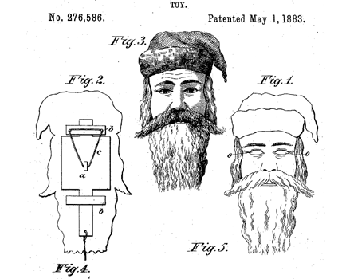
Patent #276,586 – Toy
Continue reading “Christmas Patents: Onesies, Toys, Stockings, and Cactuses”


Patent #276,586 – Toy
Continue reading “Christmas Patents: Onesies, Toys, Stockings, and Cactuses”
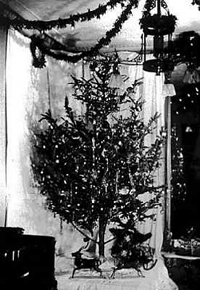
It has always been tradition to light up the Christmas tree with some kind of lights. Despite the danger of fire, candles had been used to light up the Christmas tree. In 1882, Edward Johnson demonstrated a new way to light up the tree. Johnson created the first string of electric Christmas lights. He hand wired 80 red, white and blue light bulbs and strung them on his tree in New York City.
The event was reported by a visiting journalist from the Detroit Post and Tribune.
“Last evening I walked over beyond Fifth Avenue and called at the residence of Edward H. Johnson, vice-president of Edison’s electric company. There, at the rear of the beautiful parlors, was a large Christmas tree presenting a most picturesque and uncanny aspect. It was brilliantly lighted with many colored globes about as large as an English walnut and was turning some six times a minute on a little pine box. There were eighty lights in all encased in these dainty glass eggs, and about equally divided between white, red and blue. As the tree turned, the colors alternated, all the lamps going out and being relit at every revolution. The result was a continuous twinkling of dancing colors, red, white, blue, white, red, blue—all evening.
I need not tell you that the scintillating evergreen was a pretty sight—one can hardly imagine anything prettier. The ceiling was crossed obliquely with two wires on which hung 28 more of the tiny lights; and all the lights and the fantastic tree itself with its starry fruit were kept going by the slight electric current brought from the main office on a filmy wire. The tree was kept revolving by a little hidden crank below the floor which was turned by electricity. It was a superb exhibition.” Continue reading “Brightening the Holidays: The Invention of Christmas Lights”
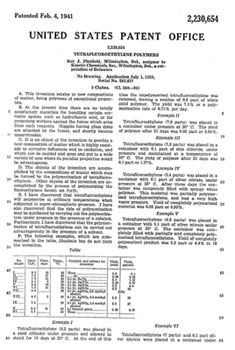 Teflon is yet another product invented entirely by mistake. Roy Plunkett, a research chemist at Dupont, was experimenting with synthesizing new types of refrigerant gas when he accidentally produced Teflon.
Teflon is yet another product invented entirely by mistake. Roy Plunkett, a research chemist at Dupont, was experimenting with synthesizing new types of refrigerant gas when he accidentally produced Teflon.
On the morning of April 6, 1938, Plunkett and his technician assistant, Jack Rebok, were setting up for an experiment with the refrigerant gas tetrafluoroethylene (TFE). Plunkett hoped to make a refrigerant by reacting hydrochloric acid with TFE. Plunkett had made a hundred pounds of the gas, to be sure to have enough for all his chemical tests, and for toxicological tests as well. He stored the gas in metal cans with a valve release. Plunkett kept the cans on dry ice, to cool and liquefy the TFE gas. One of the pressurized cylinders of TFE that they had filled failed to discharge when its valve was opened. They weighed the tank to see if the gas had leaked out but it was still full. They tried to unclog the valve but still nothing came out. Rebok suggested sawing the tank in half to see what had gone wrong. Despite the danger of explosion, Plunkett agreed. Inside the cylinder they found a white power. The gas had solidified through polymerization. Continue reading “Non-stick for your Morning Breakfast: The Invention of Teflon”
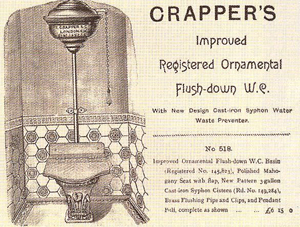
Thomas Crapper was a British plumber who did improve the functionality of the flush toilet. He even held nine patents, three of which were for improvements to the water closet. But no, contrary to popular belief, Thomas Crapper didn’t actually invent the flush toilet.
Credit for the toilet should actually go to 16th-century author Sir John Harrington. Harrington was an author and in 1596, he wrote an article named “Plan Plots of a Privy of Perfection.” In this article, he described his idea of a flush toilet. Queen Elizabeth I was so impressed by his idea that she asked Harrington to install one in the Royal Palace. She even bound and hung his article next to the toilet. This new flush toilet was not properly vented and sewer gas constantly leaked into the Royal bathroom. Bowls of herbs and fragrances were placed around the room to remedy this problem. This odd invention made Harrington an object of ridicule and he never built another one. After Harrington died, the toilet was taken out of the palace and remained unpopular for the next 200 years. Continue reading “Did Crapper Invent the Flushing Toilet?”

The large armies of the 18th century required a reliable source of quality food. Limited food availability was among the reasons the extensive military campaigns were limited to the summer and fall months. A desire to extend military campaigns and feed his army well lead Napoleon to offer a cash prize of 12,000 francs to anyone would could devise an inexpensive and reliable method of preserving food. Experimentation to win the large prize began.
Nicholas Appert, a French confectioner and brewer, conceived the idea of preserving food in bottles, like wine. He began experimenting with the idea of heating food to very high temperatures and sealing it in airtight containers. His experiments were a success and over the next 10 years he discovered that the amount of acid in the food affected the temperature and time needed for processing. Samples of Appert’s preserved food were sent to sea with Napoleon’s troops for a little over four months. Partridges, vegetables, and gravy were among 18 different items sealed in glass containers. All retained their freshness. Appert was awarded the cash prize in 1809. In 1810, he made his discovery public in an essay entitled The Art of Preserving Animal and Vegetable Substances for Several Years which included directions on how to can over 50 different foods.
Continue reading “The Invention of Food Preservation: Glass vs. Tin”
 The first US patent for PEZ, #2,620,061, was issued December 2, 1952 for a Pocket Article Dispensing Container. This patent was for the original design of the PEZ dispenser which was meant to look like a cigarette lighter.
The first US patent for PEZ, #2,620,061, was issued December 2, 1952 for a Pocket Article Dispensing Container. This patent was for the original design of the PEZ dispenser which was meant to look like a cigarette lighter.
PEZ was invented in 1927 by Austrian food company executive Edward Haas III. The original sugar tablet flavored with peppermint oil was marketed as an alternative to smoking. These candies were sold in tins until 1948 when the first dispensers were introduced. The dispenser shaped like a cigarette lighter was meant to appeal to adult smokers. The name PEZ was derived from the letters at the start, the middle and the end of the German word for peppermint, Pfefferminz, the first PEZ flavor.
Continue reading “Quitting Cold Turkey: The Invention of PEZ Candy Dispensers”
 Patent #81,437 was issued to Franz Vester on August 25, 1868 for an Improved Burial Case.
Patent #81,437 was issued to Franz Vester on August 25, 1868 for an Improved Burial Case.
This coffin was designed so that a person who was buried alive could escape. Vester’s invention included a square tube that extended above the gravesite allowing air inside the coffin. This tube had a ladder and a way for above-ground onlookers to peek inside the coffin below. A bell and cord inside could be used by the occupant to let everyone know he was still alive.
Continue reading “Halloween Patents: Coffins, Costumes, Pumpkins, and Games”
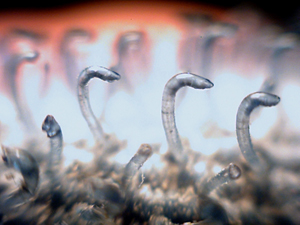 The idea for Velcro came to George de Mestral, a Swiss engineer, after returning from a walk in the Alps with his dogs. He examined the burrs stuck to both his jacket and the dogs’ fur under a microscope. The principal, he discovered, was simple. The burr was made of hundreds of hooks that would catch on anything with a loop such as cloth, animal fur or hair. De Mestral saw that this design could be used as a new type of fastener if he could duplicate the hooks and loops. Continue reading “Hooks and Loops: Who Invented Velcro?”
The idea for Velcro came to George de Mestral, a Swiss engineer, after returning from a walk in the Alps with his dogs. He examined the burrs stuck to both his jacket and the dogs’ fur under a microscope. The principal, he discovered, was simple. The burr was made of hundreds of hooks that would catch on anything with a loop such as cloth, animal fur or hair. De Mestral saw that this design could be used as a new type of fastener if he could duplicate the hooks and loops. Continue reading “Hooks and Loops: Who Invented Velcro?”
 On October 7, 1952 Bernard Silver and Norman Joseph Woodland received US Patent 2,612,994 for “Classifying Apparatus and Method.”
On October 7, 1952 Bernard Silver and Norman Joseph Woodland received US Patent 2,612,994 for “Classifying Apparatus and Method.”
In 1948, Bernard Silver, then a graduate student at Drexel University, overheard a conversation that would eventually lead to the development of the bar code. The president of a local food chain was looking for a system that would automatically read information during the check out process. Silver told another graduate student, Norman Joseph Woodland about the conversation and they began working on solutions.
Their first working system used patterns of ink that glowed under ultraviolet light. The ultraviolet ink had problems with stability and was extremely expensive to print. Still, Woodland was convinced that he had a workable idea. In order to have more time to work on the project, he quit Drexel, sold some stock and moved in with his grandfather in Florida. Continue reading “Invention of the Bar Code Patented: Saving You Time at Checkout”
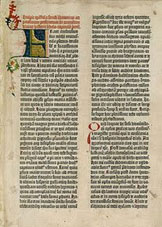 According to traditional dating, on September 30, 1452, Johann Gutenberg’s began printing his Bible which became the first book to be published in volume. The Bible, known as the 42-line Bible because there were 42 lines on each page, was very large consisting of 1280 pages. The Latin words were printed in black ink and then an illustrator added colorful designs in the margin. Two hundred copies of the two-volume Gutenberg Bible were printed, a small number of which were printed on vellum. 48 copies of this bible are known to still exist today.
According to traditional dating, on September 30, 1452, Johann Gutenberg’s began printing his Bible which became the first book to be published in volume. The Bible, known as the 42-line Bible because there were 42 lines on each page, was very large consisting of 1280 pages. The Latin words were printed in black ink and then an illustrator added colorful designs in the margin. Two hundred copies of the two-volume Gutenberg Bible were printed, a small number of which were printed on vellum. 48 copies of this bible are known to still exist today.
Continue reading “Gutenberg: Inventor of First Printing Press”